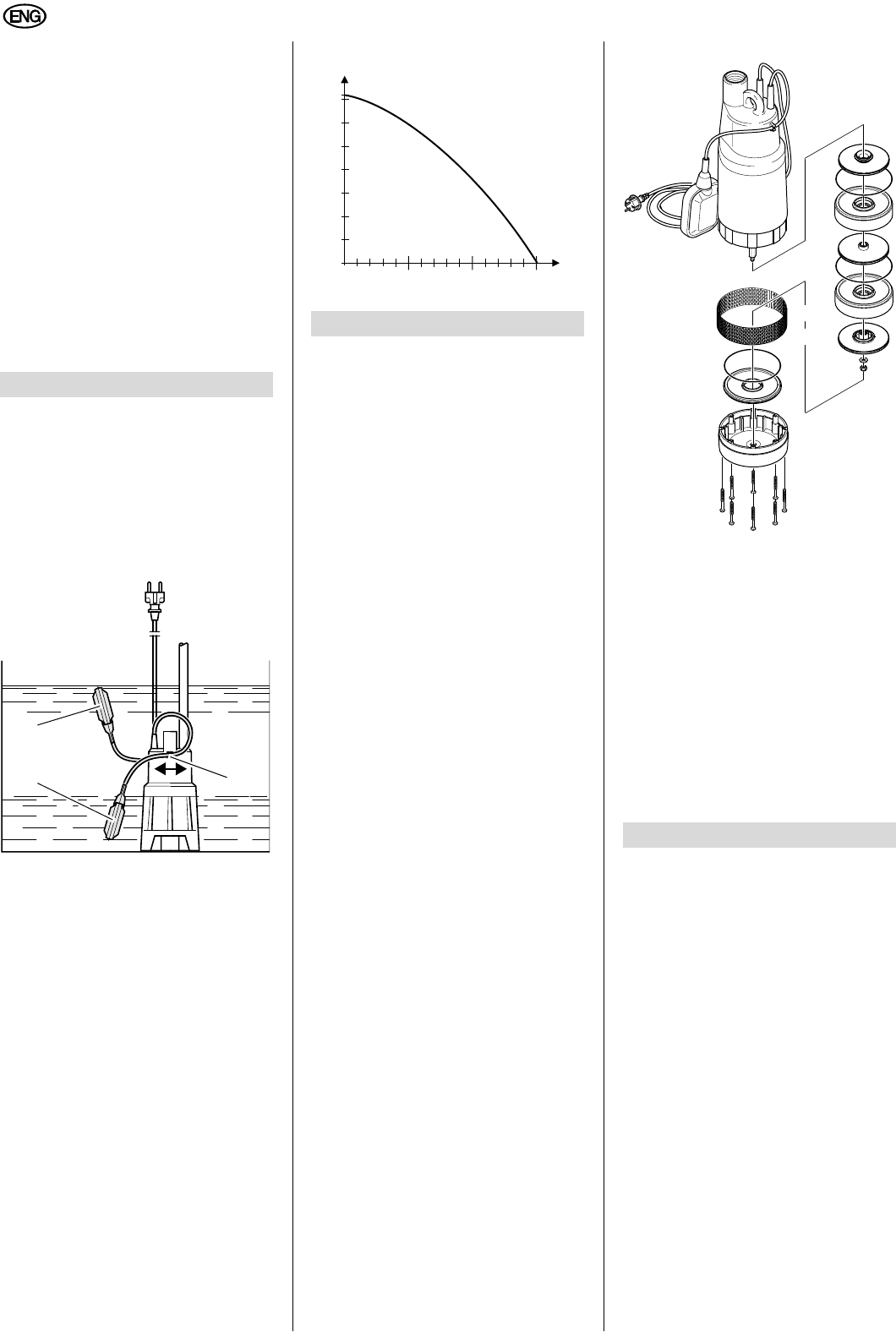
10
ENGLISH
A
Caution!
Do not lift pump at the cable or
discharge hose; both are not desig-
ned for the tensile load by the weight
of the pump.
1. Submerge pump at an angle to
avoid an air cushion at the under-
side, which would prevent priming.
Once the pump is submerged, it can
be set into an upright position.
2. Lower pump to the bottom of the
fluid container. Use a strong rope,
fastened to the cable eye, to lower
the pump.
The pump can also be operated
when suspended by a rope.
6.1 Switching ON and OFF
After connection to the mains, the sub-
mersible pump is automatically switched
ON and OFF by the float switch:
x It starts pumping when the fluid has
lifted the float switch fully (12).
x The pump switches OFF when the
float switch has fallen down (13).
The cable for the float switch can be
moved in the cable holder (14) to adjust
the distance between the switching ON
and OFF positions:
x Float switch on a "short cable": the
On and OFF positions are close
together.
x Float switch on a "long cable": the
On and OFF positions are wide
apart.
A
Caution!
The float switch must be able
to move in such way that the pump
can not run dry.
6.2 Pump characteristic
curve
The pump characteristic curve shows
which pump capacity is possible in
dependance on the delivery head.
A
Danger!
Prior to all servicing:
Switch Off.
Unplug.
Service and repair work other than
described here must be left to quali-
fied specialists.
7.1 Periodic maintenance
For the pump to function perfectly at any
time periodic maintenance is required.
This also applies if the pump is used
under heavy conditions, but does not run
for extended periods of time (e.g. when
used in well drains):
Yearly service
1. Check pump casing, cables and
float switch for damage.
2. Rinse pump with clear water.
Remove persistant soiling, e.g.
algae desposits, with brush and
dishwashing liquid.
3. To flush the inside of the pump,
place it into a container filled with
clear water and switch ON briefly.
Cleaning the impellers
A
Caution!
The impellers of a submersible pres-
sure pump are a complex component.
Some technical skill is therefore
required for cleaning. If you perform
the cleaning yourself, when disas-
sembling you must take note of the
assembly sequence and position of
the individual parts!
1. Remove strainer base.
2. Remove the impellers as illustrated.
3. Clean all component parts. Remove
persistant soiling with brush and
dishwashing liquid.
4. Reassemble pump.
7.2 Pump storage
A
Caution!
Frost damages the pump and
accessories, as both always contain
water!
x When there is danger of freezing
remove pump and accessories and
store at a frost-proof location.
A
Danger!
Prior to all servicing:
Switch Off.
Unplug.
8.1 Fault finding
Pump does not run:
x No mains voltage.
Check cables, plug, outlet and
mains fuse.
x Mains voltage too low.
Use only extension cables with
sufficient lead cross section (see
"Technical Specifications").
x Motor overheated, motor protection
relay tripped.
Remove cause for overheating
(fluid pumped too hot? Pump
blocked by foreign objects?)
After cooling off the pump will
switch ON again.
x Float switch does not switch the
pump ON.
6. Operation
14
12
13
7. Care and Maintenance
7500
l
/h
m
0
0
36
30
20
10
2500 5000
8. Trouble Shooting


















